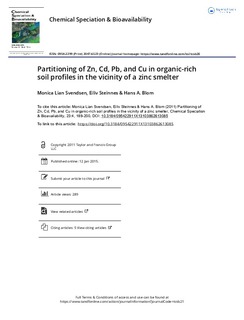| dc.description.abstract | A five-step sequential extraction procedure was applied to organic-rich soil samples from five soil profiles situated 1–8 km from a zinc smelter. The partitioning of Zn, Cd, Pb, and Cu into five operationally defined fractions (exchangeable, “carbonate’’-bound, reducible, oxidizable, and residual) was studied at different soil depths down to 35cm. In the surface soil (0–1 cm) a major part of Pb and Cu was extracted in the oxidizable fraction, whereas for Zn and Cd slightly more was extracted in the ‘‘carbonate”-fraction than in the other four fractions. Extracted metal proportions in the oxidizable fraction were respectively of the order of 30%, 20%, 50%, and 80% for Zn, Cd, Pb, and Cu in the surface soil for all sites, but these proportions decreased with soil depth. In the surface soil less than 20% of all the elements were extracted in the residual fraction, but the proportions associated with this fraction generally increased with soil depth. In the C-horizon, differences in extracted proportions of Pb and Cu in the residual fraction were probably due to geochemical factors, whereas for Zn the low extracted proportion at a highly contaminated site (20%) may be due to Zn migration to the C-horizon at this site. For Cd the extracted proportions in the C-horizon were lower than for the other elements, generally below 20%, presumably because Cd is weaker in terms of its adsorption to the soil than the other elements studied. Total concentrations of the metals decreased strongly with increasing distance from the smelter, but less systematic differences were observed for their distributions among fractions. Potentially bioavailable metal proportions (exchangeable + “carbonate”-bound fraction) in the surface soil were about 50%, 60%, 20%, and 10% for Zn, Cd, Pb, and Cu, respectively. In C-horizon soil the mobility sequence Cd>Zn>Pb = Cu was generally observed. The present results indicate that the concentrations and chemical fractionation of Zn, Pb, and Cd in these soils represent a considerable risk to natural terrestrial food chains. | nb_NO |
